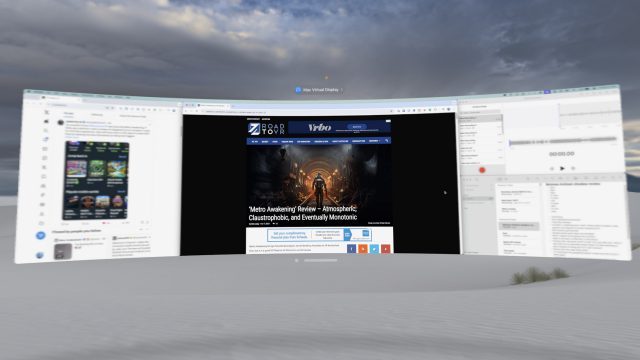Apple has recently introduced the ultrawide virtual display for Vision Pro in beta, expanding the existing virtual display feature to stretch to wider and ultrawide widths for increased screen real estate. While this feature is impressive out of the box, the default MacOS window management can be challenging to navigate. However, with the right third-party window manager, the experience surpasses expectations.
Personally, I underestimated the usefulness of the new ultrawide feature. Having utilized Vision Pro’s virtual desktop feature in the past, I appreciated the additional screen real estate it provided for my MacBook Air (M2). However, its limitation to act as a single, large 16:9 monitor left much to be desired.
As a power user who relies heavily on my desktop PC with two side-by-side monitors, the extra width offered by ultrawide displays allows me to have multiple applications open simultaneously without the constant need to minimize and maximize windows. Combining dual monitors with virtual workspaces enables me to organize applications efficiently based on specific tasks.
While the idea of switching to a single ultrawide monitor over dual monitors is appealing, the high cost and space constraints have deterred me thus far.
With the latest software update from Apple, I now have the luxury of an ultrawide monitor on the go with my Vision Pro. The ultrawide setting essentially simulates two 16:9 monitors side-by-side, without the division typically seen in dual monitor setups.
My MacBook Air now replicates the screen real estate of my extensive desktop setup, offering a seamless experience without the gap in the middle. The flexibility in setting up workspaces has significantly increased, making it easy to seamlessly span applications across the workspace while keeping less important apps on the sides. It’s a game-changer! However…
Despite Apple’s recent enhancements to window tiling in MacOS, the system still falls short in managing ultrawide monitors effectively.
At best, users can position apps in any quarter of the monitor, resulting in overly wide applications that are not practical in that layout. While splitting the screen into halves is an option, it restricts users to only two apps visible at a time.
Without dedicated window management tools for ultrawide monitors, users are left resizing windows manually to optimize screen space usage, or resort to overlapping windows in a haphazard manner as depicted in Apple’s promotional materials.
Efficiently resizing and positioning apps is crucial for maximizing the benefits of an ultrawide monitor. The quicker the process, the more likely users are to utilize the additional screen space effectively.
Fortunately, there are numerous third-party window managers available for MacOS, with the right choice being essential for optimizing the Vision Pro ultrawide virtual display.
Here is a look at MacOS’s built-in quadrant window tiling, which is inadequate for ultrawide monitors. A third-party tool significantly improves the user experience.
Currently, I have chosen to use a window manager called Rectangle. This tool allows me to effortlessly set up a ‘main’ app in the central 2/4 of the monitor, with additional apps occupying the remaining 1/4 on either side or stacked on the edges, each taking up 1/8 of the screen.
This setup enhances productivity and gives the impression of even more space compared to using two physical 16:9 monitors (the absence of a gap in the middle is surprisingly beneficial, allowing users to position their most important app directly in front).

While Rectangle offers the necessary features for efficient multitasking, the application itself can be overly complex, akin to using a sledgehammer when a regular hammer suffices. There may be more streamlined solutions available.
There is no reason why MacOS shouldn’t incorporate similar window-arranging capabilities tailored for ultrawide monitors, especially now that Vision Pro offers this functionality.
Despite the window management challenges, I find the ultrawide virtual display feature more beneficial than anticipated, particularly when combined with MacOS’s Spaces feature for seamless navigation between multiple ultrawide workspaces. My MacBook Air has transformed into a productivity powerhouse, effortlessly handling five ultrawide workspaces worth of applications while maintaining smooth performance.
For me, the ultrawide option, with the aid of third-party tools, has elevated Vision Pro’s virtual display feature from a luxury to an indispensable aspect of the headset.
Now, some readers may argue that my praise for ultrawide monitors is generic to an extent.
While that may be true, the key distinction lies in the portability factor of this ultrawide display, allowing me to carry a highly productive workspace wherever I take my laptop.
Although Vision Pro’s current weight and cost make prolonged usage impractical, the potential for a more compact and affordable Apple headset in the future promises significant value for such a versatile work setup.